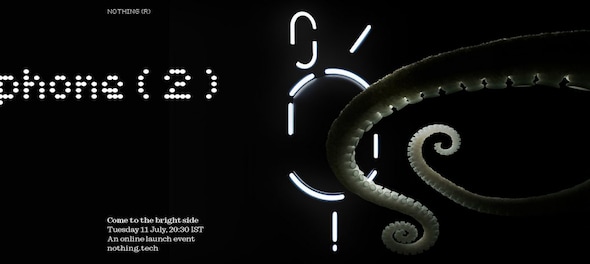
Nothing, absolutely nothing, is better at releasing distinctive, eye-catching, well-performing consumer tech devices than Nothing. Confused? I write, of course, about the London-based consumer tech company Nothing, which, apart from lending its name to my awful puns, just released its second smartphone — the Phone (2).
Nothing was kind enough to send me the highest-specced variant of the Phone (2) for review, and I've been able to use it for roughly 10 days. And not once in those 10 days did I feel like I was using a relatively lower-priced, almost flagship-level Android phone. It packs 12 GB of RAM and has 512 GB of onboard storage, and more importantly, is powered by the Snapdragon 8+ Gen 1 chipset which, till a short few months ago, was the processor that powered just about every flagship phone.
In that sense, the Nothing Phone (2) isn't exactly a successor to the Phone (1), which was a more midrange offering. Think of the Phone (2) as Nothing's attempt at a midrange premium smartphone that offers a flagship experience, while the still-excellent Phone (1) occupies the tier just below.
There are a couple of nice touches — there's a fully transparent SIM ejector pin in the box, just like last year, and an end-to-end USB Type-C charging cable, the connectors of which are encased in transparent plastic, with Nothing fully leaning into its transparent design philosophy.
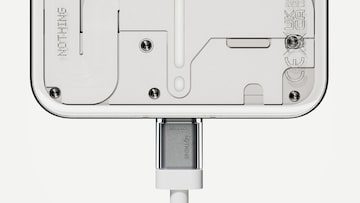 The 'transparent' Nothing Phone (2) charging connector. (Image: Nothing)
The 'transparent' Nothing Phone (2) charging connector. (Image: Nothing)Design
Nothing Co-Founder and CEO Carl Pei, who in recent months reviewed some of his competitors' flagship devices on YouTube, has always maintained that a consistent design philosophy is important for a company to make its devices instantly recognisable and stand out from the currently overstuffed smartphone market.
Nothing clearly lives by this mantra, and, at first glance, this is quintessentially a Nothing smartphone — it has the by-now iconic Glyph Interface at the back, the semi-transparent design, and vertical dual-camera array. However, the Phone (2) feels more refined than the Phone (1), clearly marking it as a second-generation smartphone from a tech startup.
While the Phone (1) has an absolutely flat front and back, making for a perfectly rectangular smartphone with rounded corners, the Phone (2) maintains the flat front, but the back slightly curves toward the edges. The result is a smartphone that has probably the best in-hand feel of any smartphone I've used so far this year — the curved back is comfortable to hold, while the flat sides make it easier to grip.
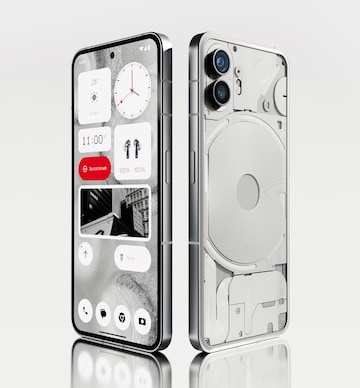 Nothing Phone (2) white variant. (Image: Nothing)
Nothing Phone (2) white variant. (Image: Nothing)It is available in two colour variants — white, just like Phone (1), and dark grey, which is my favourite. There's something about it that screams understated sophistication and style.
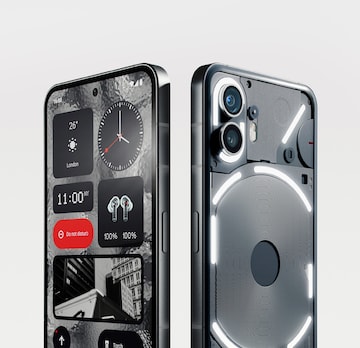 Nothing Phone (2) dark grey variant. (Image: Nothing)
Nothing Phone (2) dark grey variant. (Image: Nothing)The screen is a massive improvement over the Phone (1) too — it's now a 6.7-inch LTPO OLED display, which means it can handle dynamic refresh rate. Based on the content you're viewing, it can drop down to as low as 1 Hz and go up as high as 120 Hz. This gives you a buttery smooth user experience. It doesn't hurt that it is powered by what is still one of the best, most-poweerful and power-efficient chipsets out there.
Cameras
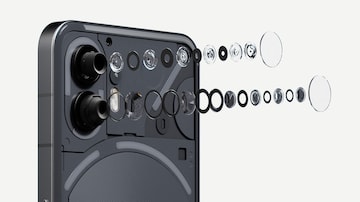 The Nothing Phone (2) has an all-new 50 MP primary sensor and a %) MP ultrawide sensor, which is the same as the one on the Phone (1). (Image: Nothing)
The Nothing Phone (2) has an all-new 50 MP primary sensor and a %) MP ultrawide sensor, which is the same as the one on the Phone (1). (Image: Nothing)The cameras are among the biggest upgrades this year. The primary sensor takes absolutely stunning phones — I will be doing a detailed camera comparison between flagship phones soon, so watch this space. For now, suffice it to say that I am extremely impressed with the main camera's performance. Nine times out of 10, it has taken better photos — across lighting conditions — than my iPhone 14 Pro Max.
On the front is a 32 MP selfie camera — now centred at the top of the screen — which is as good as any selfie camera out there.
The 50 MP ultrawide lens is the same as the one on the Phone (1), but is better tuned and takes much better photos. But, as with all ultrawide lenses, there is some softening of the subject, and sknewing at the edges.
Battery
The Phone (2) sports a 4,700 mAh battery — slightly larger than the 4,500 mAh battery in Phone (1). However, battery life was one of the chief concerns with Phone (1), though it improved with updates, and I'm happy to report that any and every issue I may have had in this regard with Nothing's first smartphone has been addressed with the Phone (2). The battery life is top-notch — even with auto-brightness turned off, I was easily able to get through an entire day without once needing a charger. Oh, and the Phone (2) now supports 45W wired charging, so it can take full advantage of the official Nothing charging brick and go from 0-100 percent in just under an hour.
While this is a far cry from the sub-30 minute charging prowess of the OnePlus 11, I've never been a fan of fast-charging as I believe it degrades the phone's battery faster, so I am more than content to charge my smartphones overnight, even if at slower speeds. And not once has the Phone (2) given me any reason to plug it in during the day.
It supports wireless charging and battery sharing as well, so feel free to throw in another smartphone or a pair of Nothing Ear (2) on the back of the phone for a quick top-up.
Glyph interface
This is where things really get interesting. The Glyph Interface has become Nothing's signature — alongside its transparent design philosophy — and while it served very basic functions last year, such as lighting up for calls or notifications, it is more refined this year,
Nothing has maintained the same Glyph Interface pattern, largely, but where the Phone (1) had five LED lighting strips, the Phone (2) has an astonishing 11. This allows for greater customisation, and opens it up to a host of new features not seen on the Phone (1).
The best features, for me, are the Glyph Timer and Glyph Progress. This allows you to set a timer and flip the phone on its back. One of the LED strips will then light up, and slowly deplete as the timer runs out. Pretty neat.
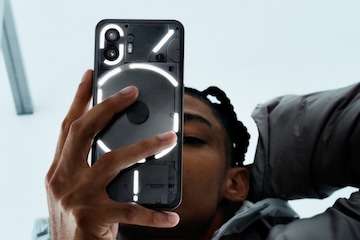 The Nothing Phone (2) features a more complex, refined Glyph Interface. (Image: Nothing)
The Nothing Phone (2) features a more complex, refined Glyph Interface. (Image: Nothing)Nothing applies the same principle to Glyph Progress, which will allow you to track the progress of the Uber coming to pick you up. For now, it is still in beta, and Nothing told me it plans to get more third-party app developers on board with this feature so that, theoretically, you can track your food order or other cab or delivery services.
Also new is the Glyph Composer, which was developed by the popular house music band Swedish House Mafia. This will allow you to use a soundboard to compose your own ringtones, replete with accompanying Glyph lights, taking you one step closer to making this your own, unique phone.
The same LED strip also flashes persistently for notifications until you address those notifications.
Nothing OS 2.0
This, perhaps, is my favourite update upgrade from the Nothing Phone (1) — Nothing OS (2) is a refined version of 1.5, and now allows you to add as many as eight widgets to the lockscreen. These widgets are fully interactive and will also show up on the Always-On Display.
For now, you can add only Nothing widgets to the lockscreen, but it will hopefully change in the future as more developers get involved.
The biggest — and perhaps the best — change is the monochromatic launcher. Nothing, through a conscious design choice, gives users the choice to use the system theme colour for all app icons on the smartphone, giving it a sense of cohesiveness that even Google's stock Android cannot pull off. It's essentially applying wallpaper colours to the systemwide settings and even supported app icons. But while in Android 13, you can only apply it to some app icons, while others retain their default colour scheme.
 The monochrome design of the Nothing OS 2.0 home launcher.
The monochrome design of the Nothing OS 2.0 home launcher.In conclusion
The Nothing Phone (2), starting at Rs 44,999, is a throwback to Carl Pei's days in OnePlus — it's a premium smartphone with near-flagship specs at a very competitive price point. With excellent cameras, battery life and refinements to its iconic design, the Phone (2) makes a compelling case over his similarly priced competitors.
Check out our in-depth Market Coverage, Business News & get real-time Stock Market Updates on CNBC-TV18. Also, Watch our channels CNBC-TV18, CNBC Awaaz and CNBC Bajar Live on-the-go!



